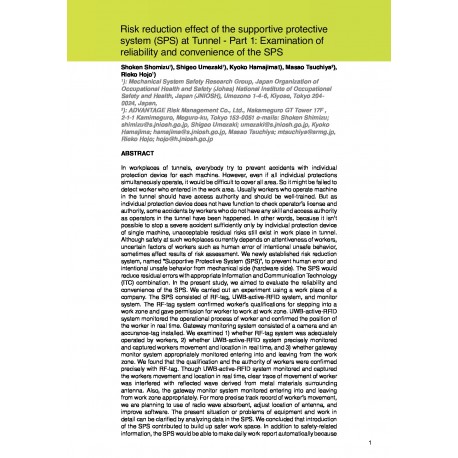Cart
0
0
No document
0,00 €
Total
Document successfully added to your shopping cart
Quantity
Total
There are 0 items in your cart.
There is 1 item in your cart.
Total documents
Total shipping
To be determined
Total
Search & filter
Search for a publication
Search & filter
Risk reduction effect of the supportive protective system (SPS) at Tunnel - Part 1: Examination of reliability and convenience of the SPS
2348_risk_reduction_effect_of_th
S. Shomizu / S. Umezaki / K. Hamajima / M. Tsuchiya / R. Hojo
In workplaces of tunnels, everybody try to prevent accidents with individual protection device for each machine. However, even if all individual protections simultaneously operate, it would be difficult to cover all area. So it might be failed to detect worker who entered in the work area. Usually workers who operate machine in the tunnel should have access authority and should be well-trained. But as individual protection device does not have function to check operator’s license and authority, some accidents by workers who do not have any skill and access authority as operators in the tunnel have been happened. In other words, because it isn’t possible to stop a severe accident sufficiently only by individual protection device of single machine, unacceptable residual risks still exist in work place in tunnel. Although safety at such workplaces currently depends on attentiveness of workers, uncertain factors of workers such as human error of intentional unsafe behavior, sometimes affect results of risk assessment. We newly established risk reduction system, named “Supportive Protective System (SPS)”, to prevent human error and intentional unsafe behavior from mechanical side (hardware side). The SPS would reduce residual errors with appropriate Information and Communication Technology (ITC) combination. In the present study, we aimed to evaluate the reliability and convenience of the SPS. We carried out an experiment using a work place of a company. The SPS consisted of RF-tag, UWB-active-RFID system, and monitor system. The RF-tag system confirmed worker’s qualifications for stepping into a work zone and gave permission for worker to work at work zone. UWB-active-RFID system monitored the operational process of worker and confirmed the position of the worker in real time. Gateway monitoring system consisted of a camera and an accurance-tag installed. We examined 1) whether RF-tag system was adequately operated by workers, 2) whether UWB-active-RFID system precisely monitored and captured workers movement and location in real time, and 3) whether gatewaymonitor system appropriately monitored entering into and leaving from the work zone. We found that the qualification and the authority of workers were confirmed precisely with RF-tag. Though UWB-active-RFID system monitored and captured the workers movement and location in real time, clear trace of movement of worker was interfered with reflected wave derived from metal materials surrounding antenna. Also, the gateway monitor system monitored entering into and leaving from work zone appropriately. For more precise track record of worker’s movement, we are planning to use of radio wave absorbent, adjust location of antenna, and improve software. The present situation or problems of equipment and work in detail can be clarified by analyzing data in the SPS. We concluded that introduction of the SPS contributed to build up safer work space.




